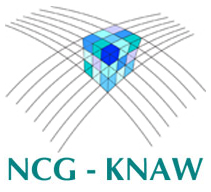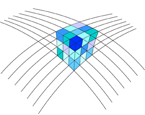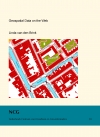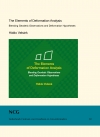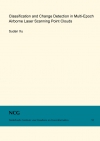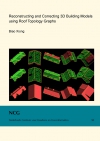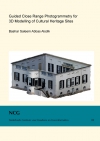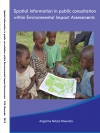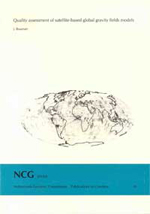
J. Bouman
Publications on Geodesy 48, Delft, 2000. 123 pagina's.
ISBN-13: 978 90 6132 270 2. ISBN-10: 90 6132 270 7.
Summary
A global model of the Earth’s gravity field may be derived from satellite observations such as satellite tracking observations or satellite gravity gradiometry (SGG). Due to the satellite’s altitude above the Earth’s surface, the gravity field recovery from satellite data is an ill-posed problem since it lacks stability. In addition, the spatial data distribution is heterogeneous in general. A physically sensible solution may therefore only be obtained by imposing constraints on the solution or by using additional surface data. The former is called regularisation.
The regularisation methods used here are all filtered least-squares solutions. Several methods are discussed as well as how to choose the filter or regularisation parameter. Regularisation yields stable solutions at the expense of introducing bias into the solution. The more the least-squares solution is filtered, the more stable the solution is and the more bias is introduced. The solution error is described by the mean square error matrix (MSEM) which includes propagated data noise and bias as well. The optimal choice for the regularisation parameter will minimise the trace of the MSEM, the so-called mean square error.
The MSEM plays a key role in quality assessment. It describes not only the accuracy of the estimated unknowns but can also be used for error propagation to derived products, computation of signal-to-noise ratio (SNR), and so on. A number of quality measures based on the MSEM is discussed. Of the quality measures, the error propagation and the ratio measures such as SNR, appear to be useful, whereas the contribution measures, which reflect the importance of the observations relative to the constraints, are less useful.
In order to compare the different regularisation methods a simulation study is conducted for SGG.
Specifically, Tikhonov regularisation (TR) with a number of different constraints is tested as well as ordinary and generalised biased estimation. A global gravity field was determined with a spatial resolution of approximately 11° using simulated SGG data leaving the polar areas uncovered. The regularisation methods perform equally well in the observation area. TR with signal constraint, however, seems to give the smallest mean square error when the unsurveyed areas are taken into account as well. Furthermore, if the error model of the observations is correct, then error analysis and simulation yield comparable conclusions on the quality.
Therefore, TR with signal constraint in combination with error analysis are used to investigate the effect of additional data as well as the effect of a change in resolution. The gradiometric observations are combined with high-low satellite-to-satellite tracking (SST) data and airborne gravimetry. The SST data are especially useful to compensate for the SGG coloured noise errors and are slightly less sensitive to data gaps. If surface gravity data are available in the uncovered areas then the ill-conditioning is largely reduced. These data, however, are not suited to overcome the ill-conditioning due to downward continuation.
The most important results are that, if only satellite data are available, the bias cannot be neglected and should be accounted for in the quality assessment. Furthermore, the bias is concentrated in the unsurveyed areas but many gravitational potential coefficients may be affected. A full understanding of the quality of a gravity field model can only be obtained by considering several quality measures. Moreover, conclusions about the quality may depend on the desired final product. Gravity anomalies, for example, are less affected by the SGG coloured noise than geoid heights.
Contents
- Summary
- Samenvatting
- Acknowledgements
- Abbreviations
- Introduction
- Parameter estimation and the associated mean square error
- Quality measures
- Gravity field observations
- Gravity field models from SGG only
- Combined solutions
- Conclusions and recommendations
- Compact operators and spectral decomposition
- Synthesis of SGG observations
- Additional results
- References
- Curriculum Vitae
Samenvatting
Een mondiaal model van het aardse zwaartekrachtsveld kan worden bepaald met behulp van satellietmethoden als satellietbaanbeschrijving en satellietgravitatiegradiometrie (SGG). Vanwege de hoogte van een satelliet boven het aardoppervlak, kan de zwaartekrachtsveldbeschrijving uit satellietmetingen worden gekarakteriseerd als een slecht gesteld invers probleem omdat het instabiel is. Bovendien is de ruimtelijke dataverdeling in het algemeen heterogeen. Daarom kan een fysisch zinvolle oplossing alleen worden verkregen door randvoorwaarden aan de oplossing op te leggen of door additionele oppervlaktedata te gebruiken. Het eerste wordt regularisatie genoemd.
Alle hier gebruikte regularisatiemethoden zijn gefilterde kleinstekwadratenoplossingen. Een aantal methoden wordt besproken alsook de bepaling van de filter- of regularisatieparameter. Door middel van regularisatie worden stabiele oplossingen verkregen ten koste van de zuiverheid van de oplossing. Hoe meer de kleinstekwadratenoplossing wordt gefilterd, des te stabieler en onzuiverder de oplossing wordt. Door middel van de gemiddelde-kwadratischefoutenmatrix ('mean square error matrix' MSEM), die bestaat uit zowel onzuiverheid als voortgeplante meetfout, worden de fouten in de oplossing beschreven. De optimale keuze van de regularisatieparameter minimaliseert het spoor van de MSEM.
De MSEM vervult een sleutelrol in kwaliteitsbeschrijving. Niet alleen beschrijft deze de nauwkeurigheid van de geschatte onbekenden maar ze kan ook worden gebruikt voor foutenvoortplanting naar afgeleide producten, berekening van signaal-ruisverhouding (SNR), enzovoort. Een aantal op de MSEM gebaseerde kwaliteitsmaten wordt behandeld. Van deze blijken de foutenvoortplanting en de verhoudingsmaten zoals de SNR bruikbaar, terwijl de bijdragematen, die de invloed van de waarnemingen ten opzichte van de randvoorwaarden beschrijven, minder bruikbaar zijn.
De verschillende regularisatiemethoden worden vergeleken met behulp van een simulatiestudie voor SGG. Tikhonov regularisatie (TR) met verschillende randvoorwaarden en gewone en gegeneraliseerde onzuivere schatting worden getest. Daartoe wordt een mondiaal zwaartekrachtsveld bepaald met een ruimtelijke resolutie van ongeveer 1° uit gesimuleerde SGG-data die de poolgebieden niet bedekken. De regularisatiemethoden geven gelijke resultaten in het gebied met metingen, maar in de niet bedekte gebieden presteert TR met signaalrandvoorwaarde het best. Bovendien kan geconcludeerd worden dat, indien het foutenmodel van de waarnemingen correct is, foutenanalyse en simulatie vergelijkbare conclusies aangaande de kwaliteit opleveren.
Dat is de reden dat het effect van additionele data en het effect van een veranderende resolutie wordt onderzocht met TR met signaalrandvoorwaarde in combinatie met foutenanalyse. De gradiometrische waarnemingen worden gecombineerd met satelliet-naar-satellietmetingen (SST) en vliegtuiggravimetrie. De SST data zijn speciaal geschikt ter compensatie van de gekleurde ruis op de SGG-waarnemingen. Bovendien zijn ze iets minder gevoelig voor een heterogene bedekking. De slechte conditionering wordt grotendeels gereduceerd indien oppervlaktezwaartekrachtdata beschikbaar zijn in de niet bedekte gebieden. Deze data zijn echter niet geschikt om de slechte conditionering ten gevolge van de neerwaartse voortzetting op te heffen.
De belangrijkste resultaten zijn dat, als alleen satellietdata beschikbaar zijn, de onzuiverheid niet verwaarloosd kan worden en meegenomen moet worden in de kwaliteitsbeschrijving. De onzuiverheid concentreert zich in de gebieden zonder metingen, maar vele zwaartekrachtspotentiaal coëfficiënten kunnen worden aangetast. Een volledig inzicht in de kwaliteit van een zwaartekrachtsveldmodel kan alleen worden verkregen door meerdere kwaliteitsmaten te beschouwen. Voorts kunnen de conclusies aangaande de kwaliteit afhangen van het eindproduct. Zo zijn bijvoorbeeld zwaartekrachtsanomaliën minder gevoelig voor de gekleurde ruis van SGG dan geoïdehoogtes.
